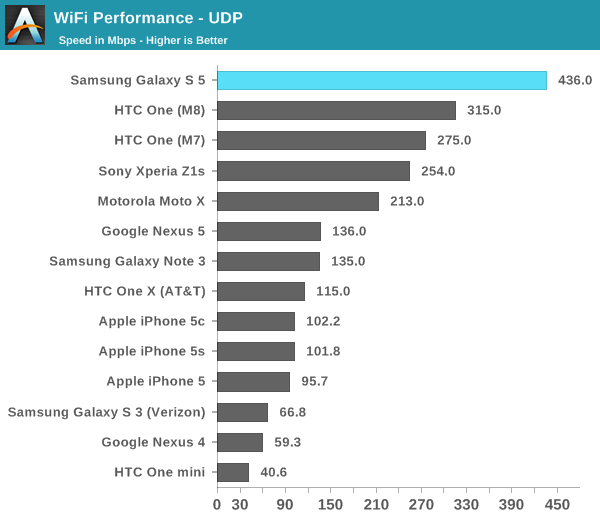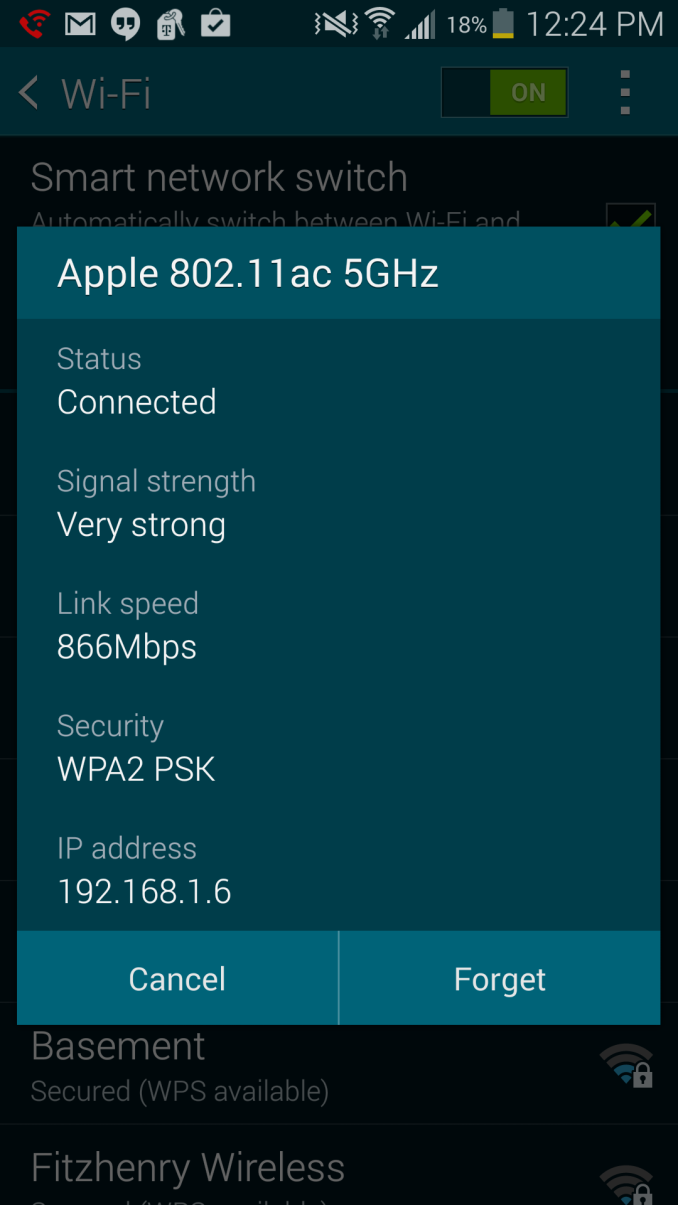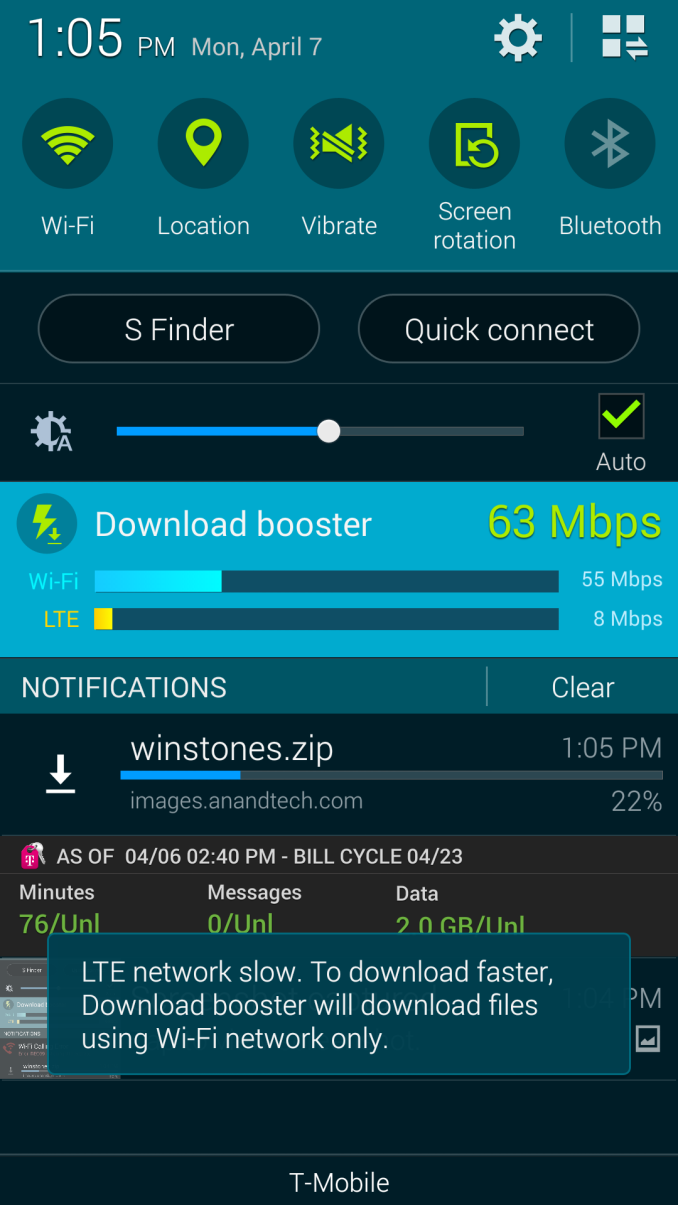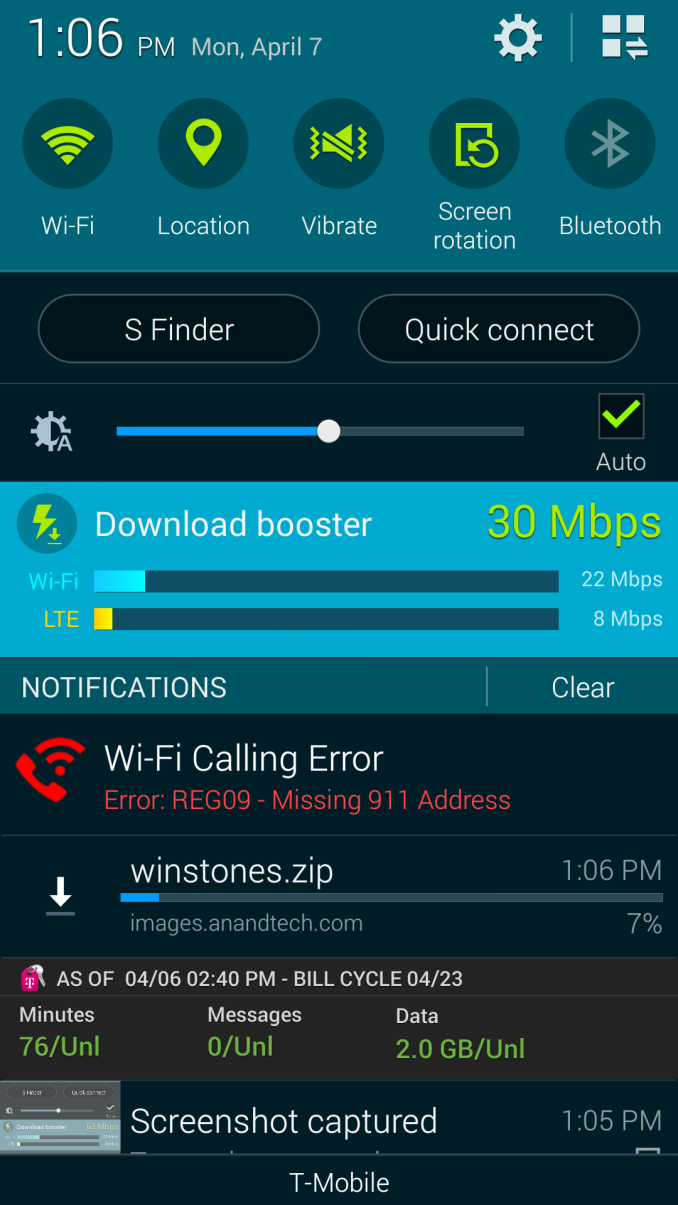Samsung Galaxy S 5 Review
by Anand Lal Shimpi & Joshua Ho on April 8, 2014 12:00 AM EST- Posted in
- Smartphones
- Samsung
- Mobile
- Galaxy S 5
WiFi, Cellular & Download Booster
At MWC this year Broadcom announced its BCM4354 802.11ac 2x2 MIMO WiFi combo chip for smartphones/tablets, which found its way into the GS5. The result is a smartphone capable of negotiating with an 802.11ac AP at 867Mbps, and transferring data at up to 436Mbps.
Although peak performance is nice, there are also power benefits to being able to transfer data quickly over WiFi (race to sleep applies to network interfaces as well).

The Snapdragon 801 features Qualcomm's integrated category 4 LTE 9x25 modem core. As I mentioned in our power analysis, Samsung also chose to include Qualcomm's QFE1100 envelope tracker (just like in the Galaxy Note 3). The GS5 is also the first flagship Samsung device to include support for 2 carrier aggregation on supported LTE networks. Samsung doesn't appear to be using Qualcomm's antenna tuner or any other RF360 components in the Galaxy S 5.
Seamless transition between network interfaces is one component of Qualcomm's vision of the future of connected devices. The problem is presently more of a software one than a hardware challenge. Samsung is beginning to explore software abstraction of underlying network interfaces with the GS5's software stack. There's now an option to prevent transitioning to WiFi networks that don't offer an improved network experience compared to your broadband connection. I haven't had a ton of time to test this feature out yet but it's something I plan on messing with more over the coming weeks.
The other big feature is what Samsung is calling Download booster. If enabled and under the right conditions, download booster allows you to combine WiFi and cellular network interfaces to accelerate large file downloads. All you have to do is enable download booster and you'll get a notification if it's active and working:
Download booster uses HTTP range requests to divide up files between the two network links. The feature can migrate data sessions from one link to another (WiFi to LTE, LTE to WiFi). Supported apps include the Play Store, YouTube, Facebook photo/video downloads, Samsung apps and standard HTTP web browsing (both Samsung's own browser and third party browsers). FTP and UDP aren't supported, nor is HTTPS.
There are other limitations as well. File downloads smaller than 30MB won't trigger download booster. Similarly, if one of the interfaces is substantially faster than the other download booster won't activate either. My home internet connection can regularly pull files down at 50 - 60Mbps, compared to < 10Mbps for T-Mobile LTE. When I was getting ~7Mbps over LTE and 50Mbps over WiFi, download booster automatically turned itself off. If I throttled my home network to 22Mbps however, download booster did its thing and gave me a healthy combined download speed of 30Mbps.
Download booster is a neat feature, although of limited use for those of us without truly unlimited high speed data plans. That being said, if you need to speed up a download in a pinch it's a great way to do that. I'm often at a press event wanting to download a benchmark onto a device as quickly as possible, usually without great WiFi or cellular reception - I can see download booster being very useful there at least.













296 Comments
View All Comments
solipsism - Tuesday, April 8, 2014 - link
I didn't notice any comments about CPU benchmark doping. Does this mean the G5 is clean?kyuu - Tuesday, April 8, 2014 - link
That issue is explicitly addressed in the article in paragraph two of page seven.tipoo - Tuesday, April 8, 2014 - link
It says as much in the CPU section. Appears clean.Nintendo Maniac 64 - Tuesday, April 8, 2014 - link
No mention of the Professional Photo mode and how said mode is optimized for the Adobe RGB color gamut?JoshHo - Tuesday, April 8, 2014 - link
I ran the numbers for all the display modes, but Cinema mode has the best accuracy for sRGB.Nintendo Maniac 64 - Tuesday, April 8, 2014 - link
Uhh... Adobe RGB is a completely different color gamut than sRGB, it's about 17% wider than sRGB.JoshHo - Tuesday, April 8, 2014 - link
Yes, I understand. Adobe RGB content is effectively nonexistent as sRGB remains the standard, thus we only target sRGB for the calibration test.Mooseparade - Tuesday, April 8, 2014 - link
I honestly wish Android phones stopped getting bigger. I upgraded from an HTC Thunderbolt to an S3 about 2 years ago and still haven't got used to such a big phone. I'm seriously considering switching to the iPhone simply for the overall phone size.devione - Tuesday, April 8, 2014 - link
There's the Xperia Z1 Compact for that.And rumour has it the Z2 Compact is on its way.
solnyshok - Wednesday, April 9, 2014 - link
Too bad that z1 compact is too fat and heavy. It weighs same as LG G2 which has got much bigger screen